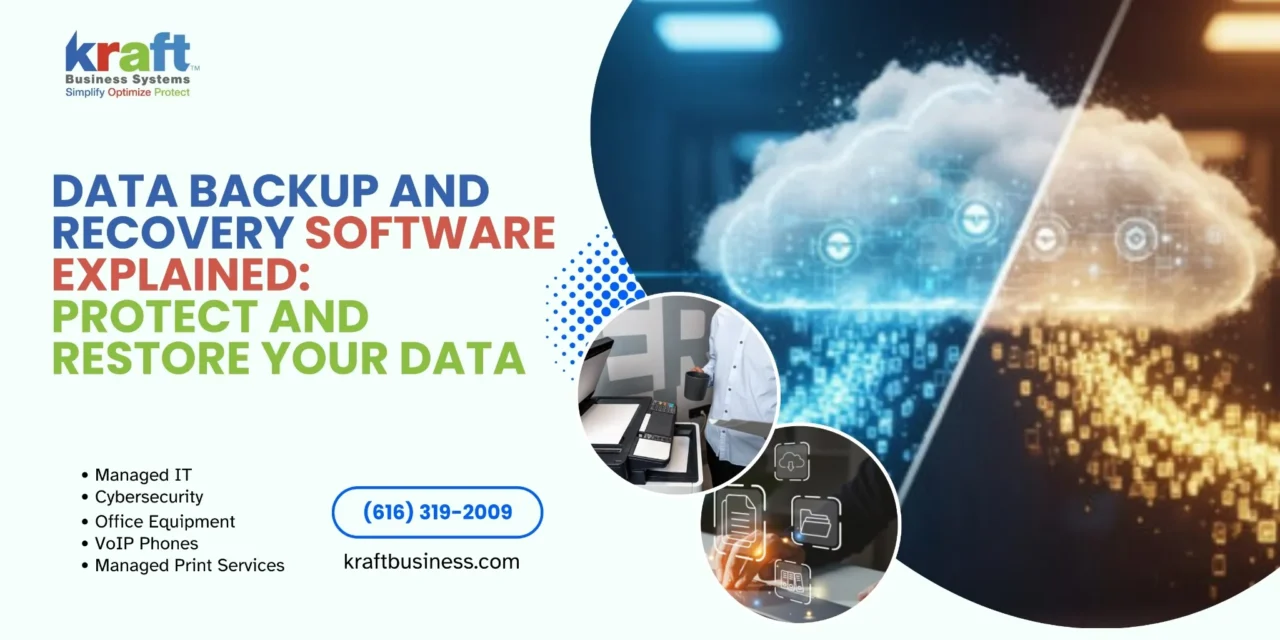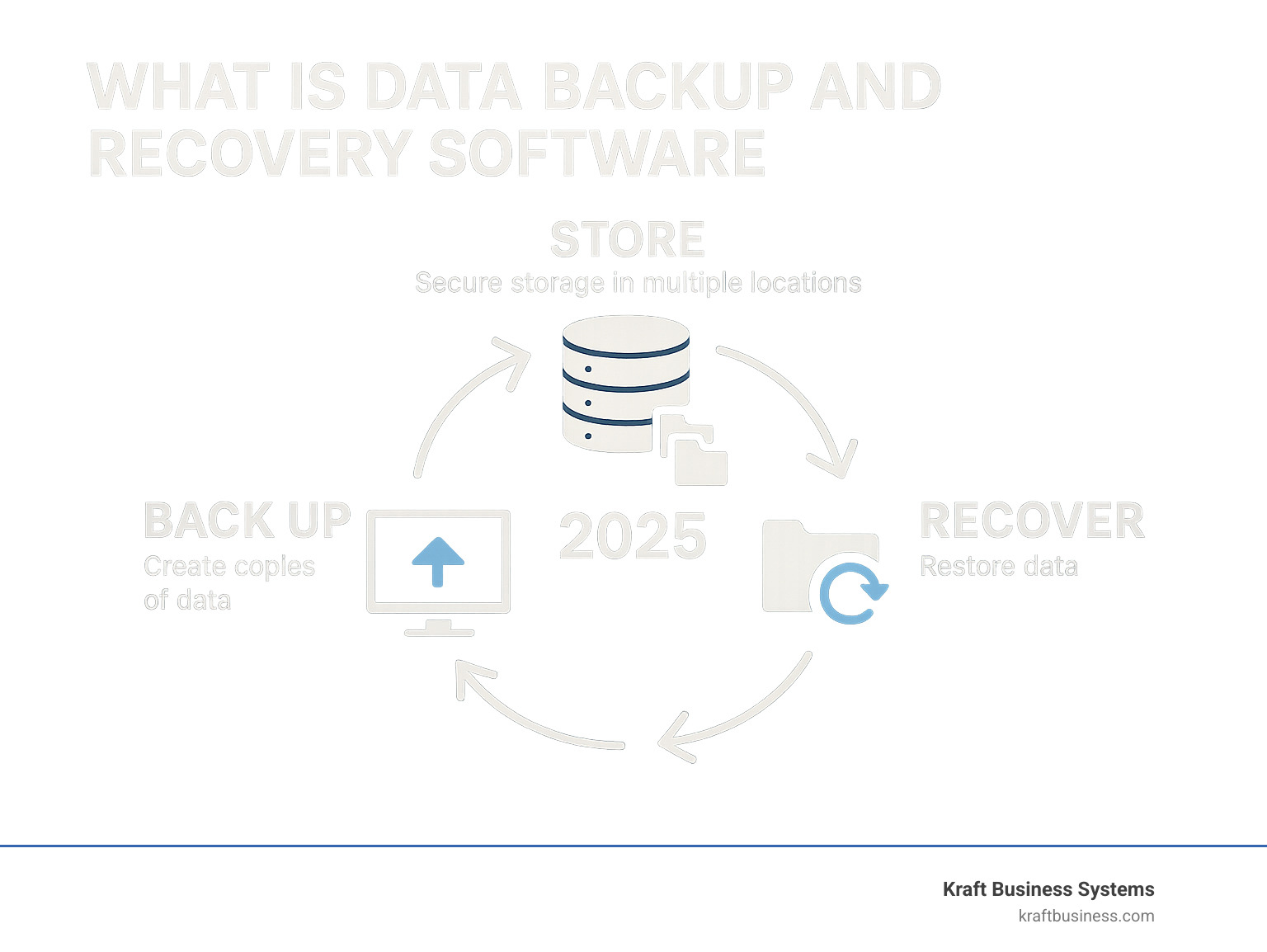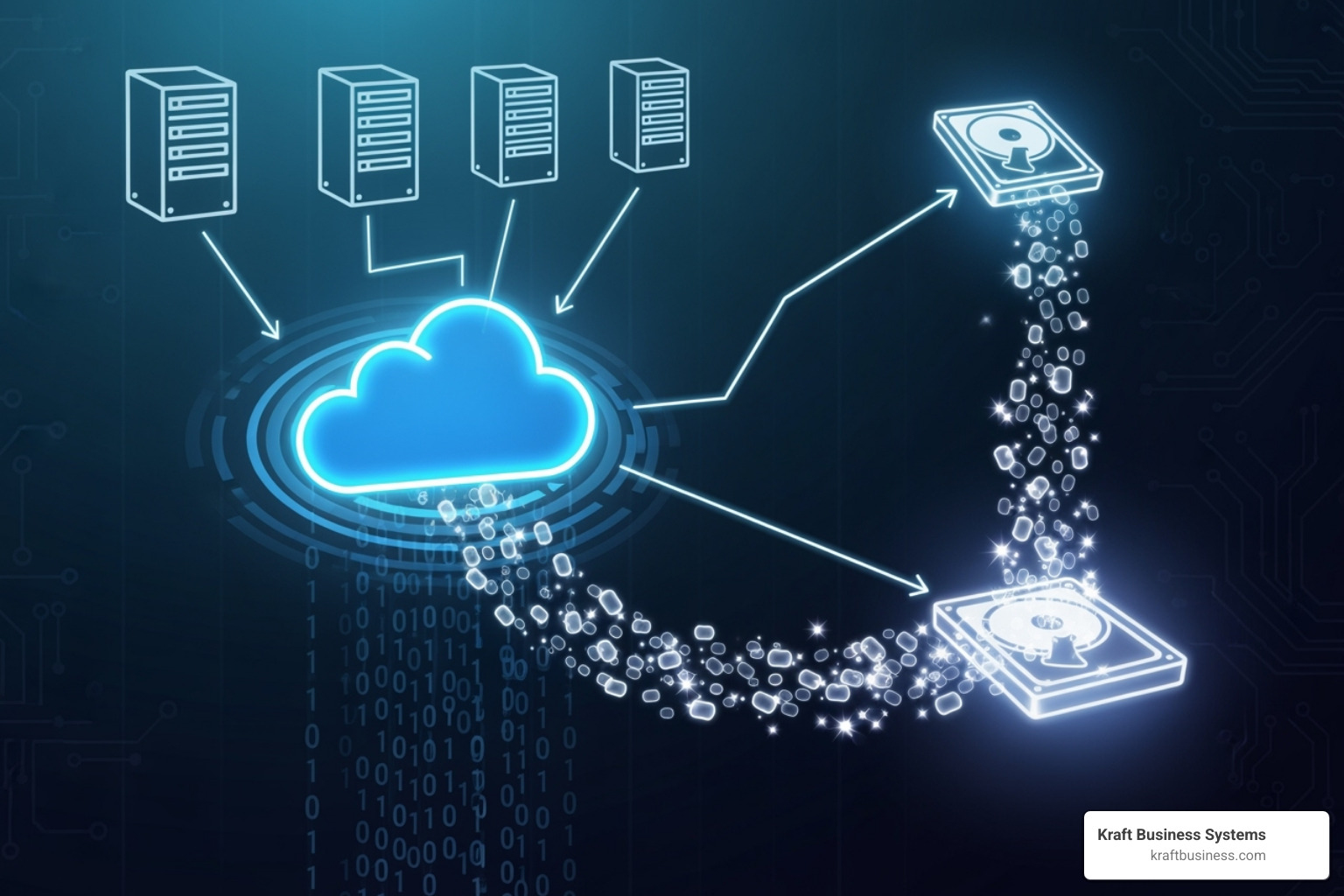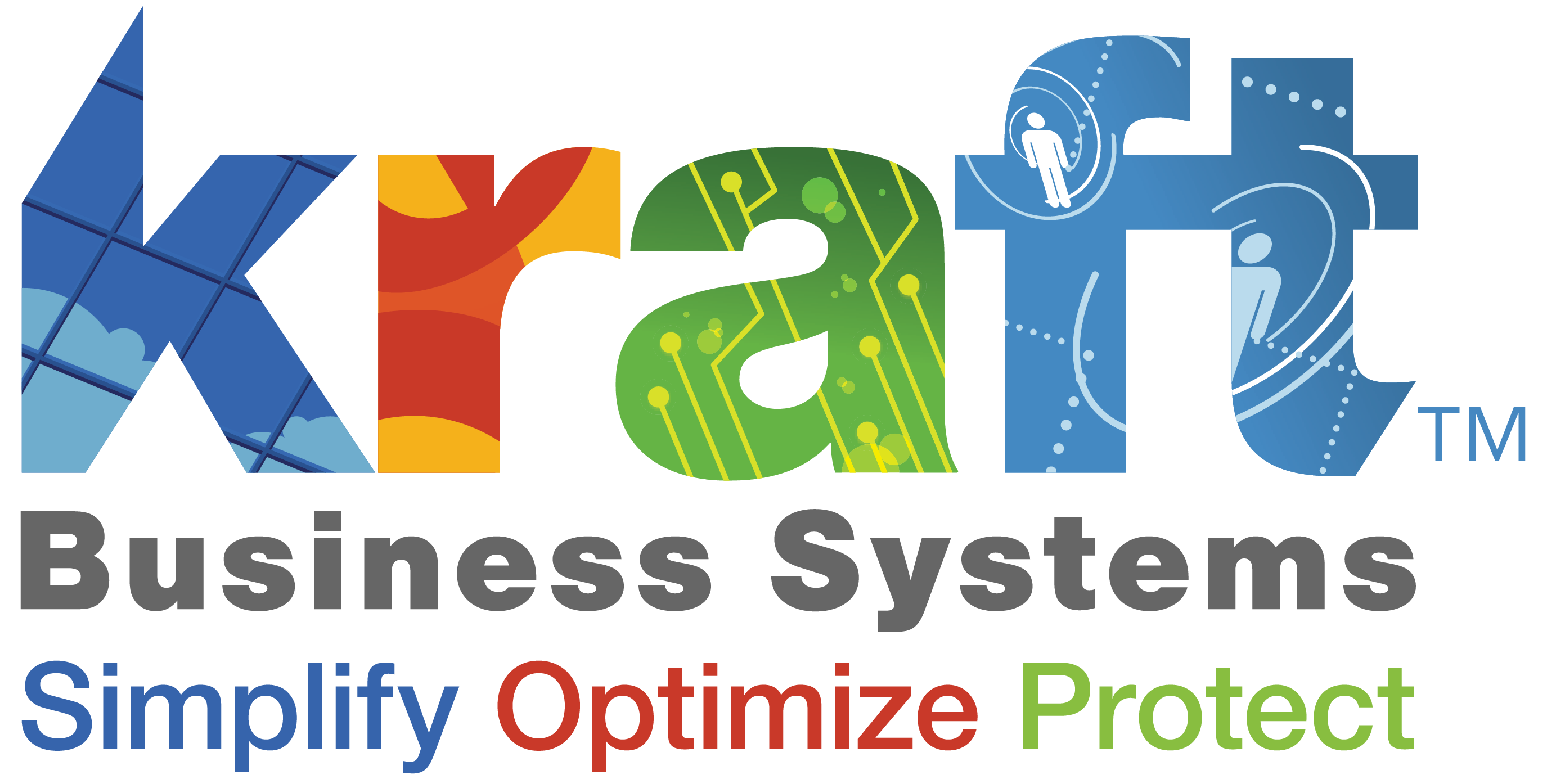What is data backup and recovery software is a computer program that automatically creates copies of your data and stores them in secure locations, then helps you restore that data when it’s lost, corrupted, or compromised.
Here’s what data backup and recovery software does:
- Creates secure copies of your files, databases, and entire systems
- Stores backups in multiple locations (local drives, cloud, or remote servers)
- Automates the backup process with scheduling and monitoring
- Restores lost data quickly when disasters strike
- Protects against ransomware, hardware failures, and human error
Your business data is your most valuable asset. Customer records, financial information, employee files, and operational systems power everything you do. But this critical information faces constant threats.
Hardware can fail without warning. Ransomware attacks encrypt entire networks. Employees accidentally delete important files. Natural disasters can destroy physical servers. The National Cybersecurity Alliance reports that 60% of small businesses close within six months after significant data loss.
Data backup creates copies of your information and stores them safely. Data recovery restores those copies when something goes wrong. Together, they form your business’s safety net against catastrophic loss.
Modern backup and recovery software automates this entire process. It runs in the background, creating copies on schedule, monitoring for problems, and standing ready to restore your operations when disaster strikes.
Easy what is data backup and recovery software word list:
What is Data Backup and Recovery Software and Why is it Crucial?
Think of what is data backup and recovery software as your business’s digital insurance policy. This specialized technology goes far beyond simply copying files—it orchestrates the entire protection of your valuable business data.
The software takes on three critical roles in your business. First, it handles automation, running backups without you having to remember or manually start the process. Second, it manages scheduling, ensuring your data gets backed up at the right times without disrupting your work. Third, it provides management tools that let you monitor, control, and organize your entire data protection strategy from one place.
Here’s where many people get confused: backup and recovery are two sides of the same coin, but they’re not the same thing. Backup creates and stores copies of your data. Recovery brings that data back when something goes wrong. You need both working together to maintain true business continuity.
The stakes couldn’t be higher. When systems go down, every minute costs money—an average of $88,000 per hour according to recent studies. Without proper backup and recovery software, what should be a quick fix becomes a business-threatening disaster that can drag on for days or weeks.
Data loss happens more often than you might think, and it comes from everywhere. Hardware failures strike without warning—servers crash, hard drives die, and power outages corrupt files. Software corruption can happen when programs have bugs, viruses attack, or systems simply malfunction. Human error is surprisingly common, from accidentally deleting important files to misconfiguring systems.
Cyberattacks represent the fastest-growing threat. Ransomware doesn’t just encrypt your data—it often targets your backups too, trying to eliminate your recovery options entirely. The U.S. Department of State projects cybercrime’s annual cost will exceed $23 trillion by 2027. Natural disasters like fires, floods, and severe weather can physically destroy entire data centers, making off-site storage essential.
For small businesses, these threats are especially dangerous. The National Cybersecurity Alliance found that 60% of small businesses close within six months after significant data loss. That’s not just a statistic—it’s a warning about what happens when businesses don’t take data protection seriously.
Investing in what is data backup and recovery software isn’t just about technology. It’s about ensuring your business survives whatever comes next. The right software turns a potential catastrophe into a manageable inconvenience.
To learn more about preparing your business for unexpected disruptions, explore our guide on Business Continuity and Disaster Recovery: Is Your Business Ready?. We also offer insights into Small Business Data Protection.
The Fundamental Difference Between Data Backup and Data Recovery
Understanding the difference between backup and recovery is like knowing the difference between buying insurance and filing a claim. Both are essential, but they happen at completely different times.
Data backup is your proactive defense. It’s the process of creating copies of your data and storing them safely away from your original files. Think of it as making photocopies of important documents and keeping them in a safe deposit box. The goal is data protection—ensuring you have clean, untouched copies ready when disaster strikes.
Data recovery is your reactive response. When something goes wrong, recovery is the process of taking those backup copies and restoring them to get your business running again. This is business restoration—the actual work of bringing systems back online and getting employees back to work.
The distinction matters because many businesses focus heavily on backup but neglect recovery planning. Here’s a sobering reality: only 57% of organizations find that when they need to recover data from a backup, the data recovery is successful. Having backups means nothing if you can’t actually use them when you need them most.
Common Causes of Data Loss
Data loss comes from many directions, and understanding these threats helps you prepare for them. Hardware and software failures top the list—hard drives crash, servers malfunction, and power outages corrupt files without warning. These mechanical and electrical failures are inevitable over time.
Accidental deletion and human error cause more problems than most people realize. An employee deletes the wrong folder, an IT administrator makes a configuration mistake, or someone overwrites important files by accident. These honest mistakes can have devastating consequences.
Malicious insiders represent a threat from within your own organization. Disgruntled employees or people with unauthorized access can intentionally delete, steal, or corrupt sensitive data. Ransomware attacks have become particularly dangerous because they don’t just encrypt your data—they often target backup systems too, trying to eliminate your recovery options.
Viruses and malware can delete, corrupt, or overwrite files across your entire network. Power outages cause systems to shut down improperly, leading to data corruption. Natural disasters like fires and floods can destroy physical servers and storage devices entirely.
Theft of laptops, external drives, or entire servers can result in significant data loss, especially when the stolen devices aren’t encrypted. Each of these threats requires different protective measures, which is why comprehensive backup and recovery software is so important.
Understanding Core Backup and Recovery Strategies
To effectively protect your data, understand the different approaches to data backup. Each strategy has its own advantages and disadvantages regarding speed, storage space, and restoration complexity.
| Backup Type | Speed of Backup | Storage Space Required | Restoration Complexity | Description |
|---|---|---|---|---|
| Full Backup | Slow | High | Simple | A full backup creates a complete copy of all selected data. While it’s the most straightforward method for restoration, it’s also the most time-consuming and requires the most storage space. |
| Incremental Backup | Fast | Low | Complex | An incremental backup only copies the data that has changed since the last backup, whether it was a full or another incremental backup. This method is fast and uses minimal storage space, but restoring data can be complex as it requires the last full backup and all subsequent incremental backups. |
| Differential Backup | Moderate | Moderate | Moderate | A differential backup copies all the data that has changed since the last full backup. This makes restoration simpler than with incremental backups because you only need the last full backup and the latest differential backup. However, it requires more storage space than incremental backups. |
Data Backup and Recovery: Proven Strategies
Main Types of Data Backup
- Full Backup: This is the most basic type of backup, creating a complete copy of all selected data. While it’s the simplest to restore from, it’s also the most time-consuming and requires the most storage space.
- Incremental Backup: This method backs up only the data that has changed since the last backup (whether full or incremental). It’s fast and uses minimal storage, but restoration can be complex as it requires the last full backup and all subsequent incremental backups.
- Differential Backup: This type of backup copies all data that has changed since the last full backup. It’s a middle ground, requiring more storage than incremental backups but making restoration simpler, as you only need the last full backup and the latest differential backup.
- Synthetic Full Backup: This advanced method combines a previous full backup with subsequent incremental backups to create a new, synthetic full backup. It offers the speed of incremental backups with the simplicity of a full restore.
- Mirror Backup: A mirror backup is an exact copy of the source data, but only the latest version is kept. It’s fast for recovery but offers no protection against data corruption or accidental deletion, as those changes are mirrored immediately.
Various Types of Data Recovery Methods
- Granular Recovery: This allows you to restore individual files, folders, or even specific emails without having to restore an entire system. It’s incredibly useful for quickly recovering from accidental deletions.
- File-Level Restore: Similar to granular recovery, this focuses on restoring specific files or directories from a backup.
- System-Level Recovery (Bare-Metal Restore): This is a complete restoration of an entire system, including the operating system, applications, and data, to a new or existing machine. It’s essential for recovering from total hardware failure.
- Instant Recovery: This advanced feature allows you to run a virtual machine (VM) directly from the backup file. This minimizes downtime, as you can get a critical system back online in minutes while the full restoration happens in the background.
- Application-Level Recovery: This focuses on restoring specific applications and their data, such as Microsoft Exchange or SQL Server, ensuring that they are in a consistent and usable state.
For a deeper dive into these methods, check out our guide on Business Data Recovery Services.
Best Practices for Data Storage and Management
- The 3-2-1 Rule: This is a cornerstone of data protection strategy. It means keeping three copies of your data on two different types of media, with one copy stored off-site. This approach provides redundancy and protects against a wide range of failure scenarios.
- On-Premises Storage: Storing backups locally on network-attached storage (NAS) or dedicated backup servers offers fast recovery times. However, it’s vulnerable to on-site disasters like fire or theft.
- Cloud Storage: Storing backups in the cloud provides excellent off-site protection and scalability. It’s a key component of a modern disaster recovery plan. Learn more about Cloud Disaster Recovery Solutions.
- Hybrid Cloud Approach: This combines the speed of on-premises backups with the security of cloud storage. You can quickly restore from local backups for minor issues and rely on the cloud for major disasters.
For more detailed guidance, read our article on Best Practices for Data Backup and Recovery.
The Benefits of Implementing a Robust Data Protection Plan
Implementing a comprehensive data backup and recovery solution is more than just a technical necessity; it’s a strategic investment that yields significant benefits for your business. It allows your team to work confidently, knowing that their efforts are protected.
When you understand what is data backup and recovery software and implement it properly, you’re not just protecting files—you’re securing your business’s future. The benefits extend far beyond simple data protection, creating a foundation for long-term success.
Minimized downtime is perhaps the most immediate benefit. With efficient recovery capabilities, you can restore operations quickly after an incident. This directly translates to significant cost savings, avoiding the average $88,000 per hour cost of downtime. Think about it: every minute your systems are down, you’re losing money and potentially customers.
The cost savings go beyond avoiding downtime. Effective backup solutions reduce storage costs through compression and deduplication, and prevent the financial burden of ransomware payments. You’re essentially paying for insurance that actually works when you need it most.
Regulatory compliance becomes much easier when you have robust backup and recovery software in place. Many industries have strict regulations like HIPAA for healthcare or GDPR for data privacy that mandate data protection and retention. Without proper backup systems, you could face hefty fines and legal issues that make the cost of good software seem trivial.
Your improved security posture is another crucial advantage. Backup and recovery acts as a vital layer in your overall cybersecurity strategy. By protecting your ability to recover, it strengthens your resilience against sophisticated cyber threats. It’s like having a safety net that catches you when other security measures fail.
Business continuity means your operations can continue with minimal interruption, maintaining productivity and service delivery. Your customers won’t even know something went wrong if you can recover quickly and efficiently. This level of reliability builds trust and keeps your business running smoothly.
Risk mitigation significantly reduces the chance of permanent data loss, ensuring business continuity even when disasters strike. Whether it’s a hardware failure, cyberattack, or natural disaster, you’re prepared for whatever comes your way.
Perhaps most importantly, having a solid data protection plan helps you avoid brand damage. Data loss incidents can severely harm your reputation and erode customer trust. Reliable recovery capabilities help protect your brand image, which took years to build but could be destroyed in a single incident.
Finally, there’s the invaluable peace of mind that comes from knowing your data is secure and recoverable. This allows you to focus on your core business objectives without constant worry about “what if” scenarios. You can sleep better knowing your business is protected.
For more insights into safeguarding your business, read our Data Breach Prevention Tips and find the Cloud Data Protection: Top Powerful Benefits.
Ensuring Success with Regular Testing and Validation
Having a backup is great, but knowing it works is even better! Here’s a sobering statistic: only 57% of organizations find that when they need to recover data from a backup, the data recovery is successful. This number should make every business owner pause and think.
This statistic is a powerful reminder that merely performing backups isn’t enough. You must regularly test and validate your recovery processes. It’s like having a fire extinguisher that you never check—when you need it most, it might not work.
Recovery tests should be scheduled regularly to simulate data loss scenarios. This helps identify any weaknesses in your backup strategy or recovery procedures before a real disaster strikes. Think of it as a fire drill for your data. You wouldn’t wait for a real fire to test your evacuation plan, so why wait for real data loss to test your recovery?
Verifying data integrity through testing ensures that your backed-up data isn’t corrupted and can be fully restored to a usable state. It’s about confirming that your backup copies are truly “clean” and will work when you need them. Sometimes backups can become corrupted over time, and without testing, you won’t know until it’s too late.
Documenting procedures is crucial for consistency and effectiveness. Maintain clear, step-by-step documentation for all backup and recovery procedures. This ensures that anyone on your authorized team can perform a recovery if necessary. Your IT person might be on vacation when disaster strikes, so having clear documentation becomes essential.
Training staff goes beyond just IT administrators. Key personnel and even remote employees should understand the backup strategy, their roles in it, and what to expect during a recovery. Well-documented processes and vendor training can greatly assist in this effort. When everyone knows their part, recovery happens faster and more smoothly.
For comprehensive guidance on preparing for IT disruptions, explore our insights on IT Disaster Recovery Planning.
Achieving Business Resilience and Peace of Mind
The ultimate goal of implementing what is data backup and recovery software is to achieve true business resilience and provide invaluable peace of mind. This isn’t just about technology—it’s about building a business that can weather any storm.
Sustaining operations becomes possible even when disruptions occur. With a robust plan, your business can quickly resume normal operations, keeping productivity high and minimizing financial setbacks. Your competitors might be scrambling to recover from the same disaster that barely affects your operations.
Maintaining customer trust is perhaps one of the most valuable benefits. Protecting customer data and ensuring continuous service delivery builds and maintains trust, which is crucial for long-term customer relationships. When customers know their data is safe with you, they’re more likely to stay loyal and recommend your services.
Protecting brand reputation becomes automatic when you have strong data protection in place. Avoiding public data loss incidents and demonstrating a strong commitment to data security safeguards your brand’s image and credibility. Your reputation is one of your most valuable assets, and data protection helps preserve it.
Strategic advantage comes naturally to businesses that can reliably protect their data and quickly recover from incidents. You gain a significant competitive edge when you can continue operating while others are struggling with data loss. Data is the foundation of most business operations, and its availability powers your competitive advantage.
A well-thought-out approach to Business Continuity Planning IT integrates backup and recovery as its backbone, ensuring your business is prepared for anything that comes your way.
Conclusion: Secure Your Business’s Future with a Solid Strategy
What is data backup and recovery software isn’t just a technical question—it’s the foundation of your business’s survival strategy. We’ve walked through how this essential software automates the complex dance of protecting your data, from creating secure copies to restoring them when disaster strikes. Whether you’re facing a simple hardware failure or a sophisticated ransomware attack, having the right backup and recovery solution means the difference between a minor inconvenience and a business-ending catastrophe.
The statistics tell a sobering story. With 60% of small businesses closing within six months after significant data loss and downtime costing an average of $88,000 per hour, the question isn’t whether you can afford to invest in proper data protection—it’s whether you can afford not to.
We’ve seen how the fundamental difference between proactive backup and reactive recovery shapes your entire approach to data security. The various backup strategies—full, incremental, and differential—each serve specific purposes in your protection plan. The 3-2-1 Rule isn’t just a catchy phrase; it’s a time-tested formula that ensures your data survives whatever life throws at it.
Modern backup and recovery software does far more than simple file copying. With features like encryption, deduplication, centralized management, and immutable backups, it forms a critical layer in your cybersecurity defense. When ransomware strikes, these tools become your lifeline, offering clean, untouchable copies of your data that no attacker can corrupt or hold hostage.
The benefits extend beyond just data protection. Robust backup solutions help you maintain regulatory compliance, reduce operational costs, and most importantly, give you the peace of mind to focus on growing your business instead of worrying about what might go wrong.
Having backups is only half the battle. With only 57% of organizations finding their data recovery successful when they need it, regular testing and validation of your recovery processes are absolutely crucial. Your backup strategy is only as good as your ability to restore from it.
For businesses throughout Michigan—from the busy streets of Grand Rapids to the scenic shores of Traverse City, from the automotive heart of Detroit to the college towns of Ann Arbor and Lansing—Kraft Business Systems stands ready to help you build a data protection strategy that fits your unique needs. We understand that every business is different, and we work with you to create solutions that make sense for your operations, your budget, and your future.
Investing in robust data backup and recovery isn’t just about protecting what you have today—it’s about ensuring your business can thrive tomorrow, no matter what challenges come your way. Your data is your business’s lifeblood, and protecting it is protecting your future.
Ready to take the next step? Explore our comprehensive Backup and Disaster Recovery Services and find how we can help secure your business’s tomorrow.










